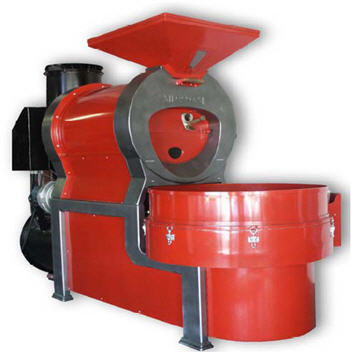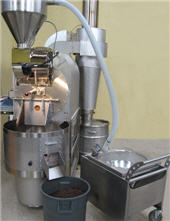Industry: Coffee and Tea Manufacturing (NAICS 3119)
NAICS Process:
Process Brief: Green coffee beans are roasted in direct-fired drums
Energy Source: Natural Gas
Energy Intensity: 700 – 1,000 BTUs per Pound of Roasted Beans EXCLUDING afterburners/incinerators for smoke and chaff control
Roasters typically operate at temperatures between 370° and 540°C (698° and 1004°F), and the beans are roasted for a period of time ranging from a few minutes to about 30 minutes. Roasters are typically horizontal rotating drums that tumble the green coffee beans in a current of hot combustion gases; the roasters operate in either batch or continuous modes and can be indirect- or direct-fired. Indirect-fired roasters are roasters in which the burner flame does not contact the coffee beans,although the combustion gases from the burner do contact the beans. Direct-fired roasters contact the beans with the burner flame and the combustion gases. At the end of the roasting cycle, water sprays are used to “quench” the beans.
The coffee roaster by CoffeePER shown in the above photo is rated for up to 1,200 lbs per hour with a gas input of 950,000 BTUs.
 The CoffeeTec roaster (red color to right) includes an integrated afterburner; the spec sheet says the gas input is 5.1 to 8.3 Million BTUs/ hour, and the capacity is over 1,000 lbs.
The CoffeeTec roaster (red color to right) includes an integrated afterburner; the spec sheet says the gas input is 5.1 to 8.3 Million BTUs/ hour, and the capacity is over 1,000 lbs.
Energy Efficiency Improvement
Manufacturers
CoffeePER, Inc
Reno, Nevada
Telephone: 775-423-8857
Web site: www.coffeeper.com
CoffeeTec.com
1111 Arguello Street
Redwood City, CA 94063
Telephone: 650-556-1333
Web site: www.coffeetec.com
3200 Dutton Avenue, Suite 413
Santa Rosa, CA 95407
Telephone: 707-526-7215
Web site: www.smartroaster.com
Our goal is to offer our customers equipment that will roast consistently and express the best qualities of a coffee. Beyond, and second only to that, we concentrate on producing machinery that drastically reduces air pollution and preserves natural gas supplies in the most efficient and cost effective way possible.
The Gas Meter Tells its Story
The Kestrel S35 dramatically reduces your operating costs, and thus increases your profit margins. From six months of actual data a reduction of 80% in natural gas consumption was calculated. The Kestrel S35 operated side by side with a conventional drum roaster with afterburner. Over a six-month period the reduction in CO2 production was 280,000 pounds. Wow!! Your monthly savings in utility costs will more than pay for any difference in initial cost between the Kestrel and any other system.


